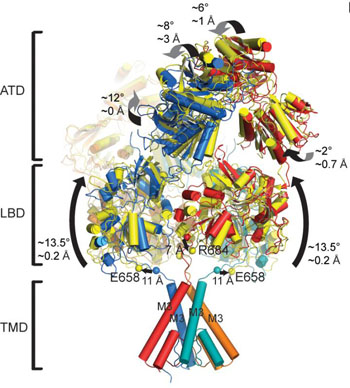Study Reveals Active and Non-Active Structures of the NMDA Receptor
By LabMedica International staff writers
Posted on 12 May 2016
Advanced imaging techniques were used to obtain the three-dimensional structure of the NMDA (N-methyl, D-aspartate) receptor in active and non-active states.Posted on 12 May 2016
The physiology of N-methyl-d-aspartate (NMDA) receptors is fundamental to brain development and function. NMDA receptors are ionotropic glutamate receptors that function as heterotetramers composed mainly of GluN1 (glycine-binding NMDA receptor subunit 1) and GluN2 (glutamate-binding NMDA receptor subunit 2) subunits. Activation of NMDA receptors requires binding of neurotransmitter agonists to a ligand-binding domain (LBD) and structural rearrangement of an amino-terminal domain (ATD). The membrane domain (TMB) contributes residues to the channel pore and is responsible for the receptor's high-unitary conductance, high-calcium permeability, and voltage-dependent magnesium block.

Image: A diagram showing how different domains of the NMDA receptor move when the receptor is in active, non-active, and inhibited states. Understanding how NMDA receptors activate is critical in designing novel therapeutic compounds for potential use in schizophrenia, depression, and other disorders (Photo courtesy of Furukawa Lab, Cold Spring Harbor Laboratory).
Previous studies have revealed the structure of the NMDA receptor in an inhibited mode induced by binding of the antagonist compound ifenprodil. Now, investigators at Cold Spring Harbor Laboratory (NY, USA) have used X-ray crystallography, single-particle electron cryomicroscopy (cryoEM), and electrophysiology to establish the structure of rat NMDA receptors in active and non-active mode.
They reported in the May 2, 2016, online edition of the journal Nature that the bi-lobed structure of GluN2 ATD adopted an open conformation accompanied by rearrangement of the GluN1–GluN2 ATD heterodimeric interface. These changes led to additional rotations at various points throughout both the ATD and LBD, causing the ion channel pore to open.
"The NMDA receptor architecture itself is quite complicated," said senior author Dr. Hiro Furukawa, an associate professor at Cold Spring Harbor Laboratory, "but most recently we have been really fascinated by how each of its domains moves in a sophisticated but organized manner. With the technology available today, we do not see continuous movement but instead we see snapshots of NMDA receptors in different functional states."
"Unless we have a library of molecular structures, people in the field will not be able to run those simulations," said Dr. Furukawa. "We hope that this new finding will help pharmacologists come up with better therapeutic compounds that have minimal side effects."
Related Links:
Cold Spring Harbor Laboratory













